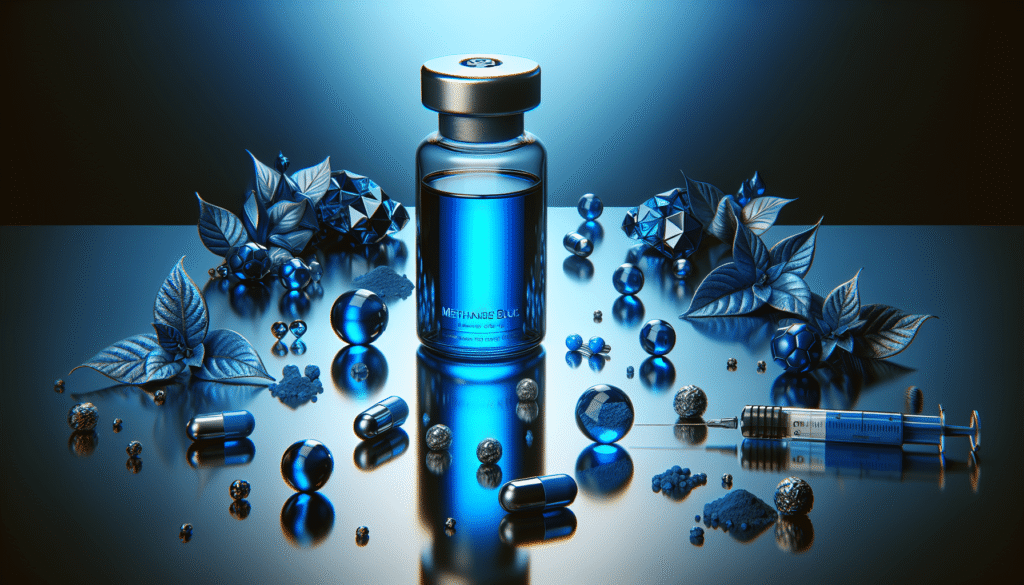
Have you ever considered how the cognitive enhancers you choose might affect your mental performance? In a world increasingly fascinated by nootropics, understanding the distinctions between these compounds is crucial. One such compound that has generated considerable discussion is Methylene Blue. This article provides an in-depth comparison between Methylene Blue and other popular nootropics, examining their mechanisms, benefits, and potential downsides.
Understanding Nootropics
Nootropics, often termed “smart drugs,” are substances that purportedly enhance cognitive function, improve memory, and boost mental clarity. They can range from natural herbs to synthetic compounds. The increasing interest in nootropics stems from the desire for a competitive edge in various fields such as academia, business, and even personal development.
Learning about nootropics can help you make informed decisions about what to include in your regimen, ensuring that you choose substances that truly benefit you without unwanted side effects.
What is Methylene Blue?
Methylene Blue is a synthetic dye that has been utilized for over a century in medical applications, primarily for its antiseptic properties. In recent years, it has gained popularity as a nootropic due to its potential neuroprotective effects. It functions by enhancing mitochondrial function, which is vital for energy production in the brain.
Mechanism of Action
Methylene Blue enhances the efficiency of mitochondria by promoting cellular respiration and ATP production. This results in improved energy levels in brain cells, ultimately contributing to better cognitive performance. Moreover, it acts as an antioxidant, reducing oxidative stress that can impair cognitive function over time.
Understanding how Methylene Blue works can give you insight into how it compares with other nootropics, particularly in terms of the types of cognitive enhancement each may offer.

Popular Nootropics to Compare
Methylene Blue is often discussed alongside several other nootropics, each with unique modes of action. Notable compounds include:
- Piracetam: Notable for its cognitive-enhancing properties, Piracetam is often recognized as one of the first nootropics developed.
- Aniracetam: A derivative of Piracetam, Aniracetam is believed to have similar benefits but may affect mood as well.
- Rhodiola Rosea: A natural herb known for its adaptogenic properties, offering potential benefits for stress and fatigue.
- L-Theanine: An amino acid primarily found in green tea, known for its calming effects and ability to enhance cognitive function when combined with caffeine.
Examining each of these nootropics alongside Methylene Blue will help you appreciate the diversity of cognitive enhancers available.
Methylene Blue vs. Piracetam
Overview of Piracetam
Piracetam is regarded as the original nootropic and has been extensively studied. It is thought to improve cognitive function, particularly in aging populations. Piracetam works primarily by enhancing communication between the two hemispheres of the brain, improving overall cognitive function.
Comparison with Methylene Blue
While both Methylene Blue and Piracetam aim to enhance cognitive performance, they do so through different mechanisms.
| Aspect | Methylene Blue | Piracetam |
|---|---|---|
| Mechanism | Enhances mitochondrial function | Improves inter-hemispheric communication |
| Cognitive Benefits | Improved energy levels, neuroprotection | Enhanced memory, learning, and focus |
| Side Effects | Staining, rare reports of anxiety | Mild headaches, gastrointestinal issues |
Methylene Blue may provide more neuroprotective benefits, while Piracetam is more focused on improving memory and learning abilities.

Methylene Blue vs. Aniracetam
Overview of Aniracetam
Aniracetam, a derivative of Piracetam, is noted for its potential to enhance not only cognitive function but also mood. This makes it particularly appealing for individuals needing both mental clarity and emotional balance.
Comparison with Methylene Blue
The contrast lies in their respective impacts on mood and cognitive enhancement.
| Aspect | Methylene Blue | Aniracetam |
|---|---|---|
| Mechanism | Enhances mitochondrial function | Modulates AMPA receptors |
| Cognitive Benefits | Energy enhancement, neuroprotection | Memory improvement, mood enhancement |
| Side Effects | Staining, rare anxiety incidents | Headaches, nausea |
While Methylene Blue focuses more on energy and protection, Aniracetam targets memory and mood stabilization, making them complementary rather than wholly comparable.
Methylene Blue vs. Rhodiola Rosea
Overview of Rhodiola Rosea
Rhodiola Rosea is an adaptogen—an herb believed to help the body adapt to stress and enhance resilience. With roots in traditional medicine, Rhodiola is praised for its ability to combat fatigue and improve mental clarity under stress.
Comparison with Methylene Blue
While both compounds can enhance cognitive function, one targets stress management while the other focuses on energy production.
| Aspect | Methylene Blue | Rhodiola Rosea |
|---|---|---|
| Mechanism | Increases ATP production | Reduces cortisol levels |
| Cognitive Benefits | Neuroprotection, energy enhancement | Stress reduction, improved focus |
| Side Effects | Staining, rare reports of anxiety | Dry mouth, dizziness |
With their different mechanisms, you may choose one over the other depending on your specific needs, such as addressing fatigue versus improving overall cognitive protection.
Methylene Blue vs. L-Theanine
Overview of L-Theanine
L-Theanine is an amino acid primarily found in green tea. It is renowned for its calming effects and the ability to enhance cognition, particularly when combined with caffeine.
Comparison with Methylene Blue
Both Methylene Blue and L-Theanine offer cognitive enhancement but in different manners.
| Aspect | Methylene Blue | L-Theanine |
|---|---|---|
| Mechanism | Enhances mitochondrial function | Promotes relaxation without sedation |
| Cognitive Benefits | Improved focus, energy | Reduces anxiety, enhances alertness |
| Side Effects | Staining, rare anxiety incidents | Mild drowsiness, headache |
While Methylene Blue is more geared towards energy and protection, L-Theanine is helpful for relaxation and enhancing focus, especially in high-pressure situations.
Potential Side Effects of Methylene Blue
When considering any nootropic, recognizing potential side effects is essential. Methylene Blue is generally regarded as safe at low doses; however, some individuals may experience adverse effects.
Common Side Effects
- Staining of urine and skin: Since Methylene Blue is a dye, it may result in vivid coloration in urine. For some, this is merely cosmetic, while for others, it might cause concern.
- Anxiety and restlessness: Though rare, some individuals report increased anxiety or restlessness when using Methylene Blue.
- Digestive issues: Some users have experienced nausea or gastrointestinal discomfort due to Methylene Blue.
The Ergogenic Properties of Methylene Blue
Methylene Blue’s ergogenic properties primarily stem from its ability to enhance energy production. When assessing its efficacy as a nootropic, it is worthwhile considering its impact on physical performance as well.
Benefits for Physical Performance
- Enhanced endurance: By increasing ATP production, Methylene Blue may improve endurance during physical tasks, allowing for extended periods of focus and stamina.
- Reduced fatigue: Its neuroprotective qualities might aid in quicker recovery from mental and physical fatigue.
By recognizing these additional benefits, you can appreciate Methylene Blue’s versatility beyond cognitive enhancement.
Appropriate Dosage of Methylene Blue
When integrating Methylene Blue into your regimen, understanding the appropriate dosage is crucial for maximizing benefits while minimizing side effects.
Recommended Dosage
- Typical doses: Common recommendations range from 0.5 mg to 4 mg per kilogram of body weight, though some users cite efficacy with lower amounts.
- Caution: High doses can lead to more pronounced side effects. It is essential to start with lower doses and gradually increase as needed.
Always consult with a healthcare provider before introducing Methylene Blue or any new nootropic to your routine.
Conclusion
In your search for cognitive enhancers, Methylene Blue stands out as a promising compound with unique properties. When compared to other popular nootropics like Piracetam, Aniracetam, Rhodiola Rosea, and L-Theanine, it is clear that each has its strengths, weaknesses, and mechanisms of action.
Choosing the right nootropic for your needs will depend on the specific cognitive enhancements you seek. While Methylene Blue offers distinct advantages, particularly in mitochondrial function and neuroprotection, it may benefit from being part of a broader regimen that includes other nootropics, depending on your personal goals.
As you navigate the vast landscape of cognitive enhancers, equip yourself with knowledge. A thorough understanding of how each compound operates will allow you to tailor your cognitive enhancement strategy, ultimately leading to improved mental performance in both your personal and professional life.